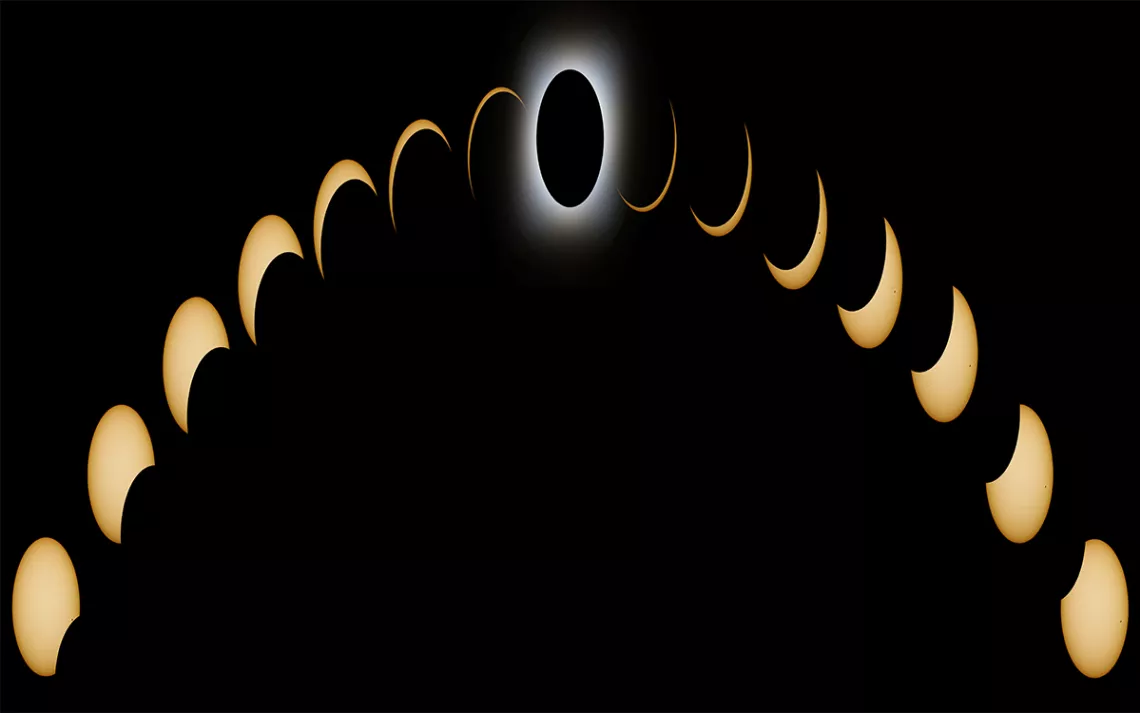August Observing Highlight: Total Solar Eclipse
Here's what you need to know to experience this rare astral event

Illustration by Allexxandar/iStock
The last total solar eclipse to touch the mainland United States was in February 1979, when the moon’s shadow cut a small swath in the northwest. Now, 38 years later, a total eclipse will occur this month on August 21.
Anything less than a total eclipse requires protective lenses, and that includes the beginning and end stages for those who are in the path of totality—not just in the United States but in all of North America. Eclipse glasses are for sale online, so you can view the eclipse without damaging your eyesight.
For those who find themselves unprepared on August 21, you can also use a pinhole projection to see how much of the sun is covered by looking at the moon-obstructed shadows cast on a piece of paper. Even sunlight filtering through leaves can show shadows on the ground or against the side of a building.
The time of the eclipse will differ depending on your location. In Salem, Oregon, for example, the partial eclipse will begin at 9:05 A.M., with totality lasting just under two minutes, from 10:17 to 10:19 A.M., and the partial phase ending at 11:37 A.M. The longest eclipse will occur in southern Illinois, with totality lasting for two minutes and 40 seconds, from 1:20 to 1:23 P.M. The eclipse exits the mainland from South Carolina after sweeping across Nashville and Charleston.
Here’s a guide for how to experience this rare astral event:
- Shadow bands. Because Earth has an ever-flowing atmosphere, the edge between darkness and light won’t be precisely defined, but will waver as it passes through layers of air. This results in a flickering darkness and light at the beginning and end of the eclipse, as well as in locations where the eclipse is between the border of partial and total.
- Racing shadow. If you have a flat view to the west, say from the vantage point of a mountaintop or out on the plains, you may be able to see the shadow of the moon racing toward you across the landscape at up to 2,000 miles per hour.
- Diamond ring. As the moon passes in front of the sun, the last remaining fragment of sunshine creates a thin band of light with one bright spot that shines like a diamond.
- Bailey’s beads. Bailey’s beads are the only light still seen from the sun, which will pour through valleys and other low spots on the moon's surface.
- Chromosphere. The reddish pink layer of the sun’s atmosphere may show up around the edges of the moon.
- Solar prominences. Depending on how active the sun is at the time, giant flames of gas may be leaping off the sun far enough to be seen against the backdrop of space.
- Corona. The previous events occur for just seconds. Once totality is underway, the corona will appear as a wispy light behind the black dot covering the sun. The corona is the outermost layer of the sun’s atmosphere, which is very diffuse but appears during totality. Ironically, it is extremely hot; at nearly 2 million degrees Fahrenheit, it’s hotter than the surface of the sun.
Notice your surroundings. As the day grows darker, the birds will quiet their songs. The temperature drops. During totality, stars and planets can be seen where they had been overpowered by sunlight. Wear eclipse glasses to safely view the diamond ring, Bailey’s beads, chromosphere, and solar prominences. When looking at the sun, only remove your eclipse glasses for the brief one-to-two minutes of totality.
If you miss the eclipse, keep in mind that the next one isn’t as far away. You get a second chance in seven years. On April 8, 2024, another total solar eclipse crosses a portion of the United States from Texas to Maine.
The total solar eclipse is the biggest astronomy event of the year, but it’s not the only observing opportunity in August. The ever-popular Perseid meteor shower peaks overnight from August 12/13 with up to 100 meteors an hour possible. The full moon on August 7 means a still-fairly-bright waning moon could obscure some of the meteors.
Look for Saturn by the moon on August 2 and again on both the 29th and 30th. On August 16, the moon and Aldebaran are particularly close together, but you have to be up in the wee hours of the morning to spot them. For those witnessing the total solar eclipse, look for Jupiter, Mercury, Mars, and Venus from east to west. The bright star Aldebaran in Leo will be the closest point of light near the eclipsed sun and its shimmering corona. Don’t expect too much from the night sky during the day, however, because the shortness of the eclipse doesn’t allow your eyes time to adjust to the darker sky.
 The Magazine of The Sierra Club
The Magazine of The Sierra Club







